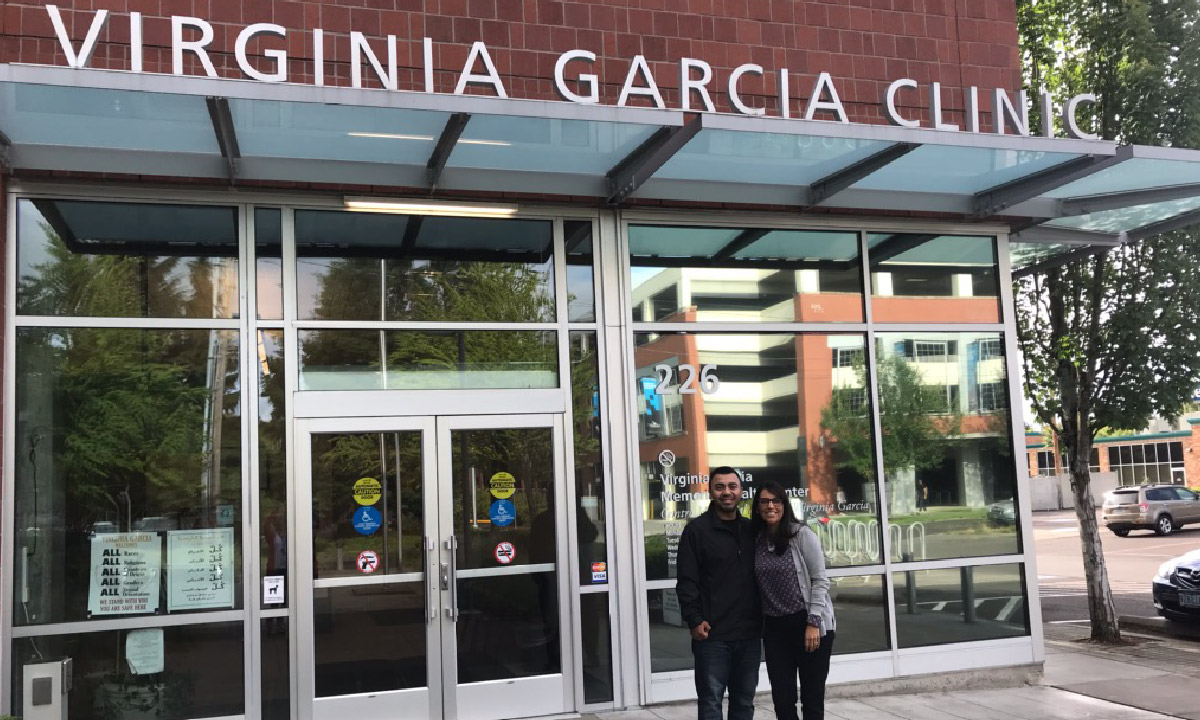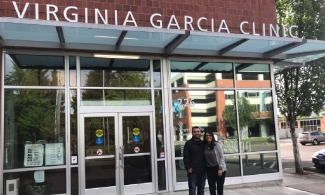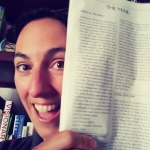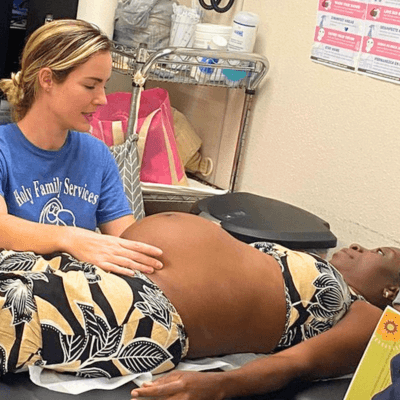Diabetes Clinical Teams: Q&A with Kevin Alfaro-Martinez, Eva Galvez, MD, and Sarah Deines, PharmD, from Virginia Garcia Memorial Health Center

Kevin Alfaro-Martinez and Eva Galvez stand in front of health center.
Kevin Alfaro-Martinez is a Primary Care Community Outreach Worker at Virginia Garcia Memorial Health Center, a community health center with several clinics in the suburban and agricultural regions just west of Portland. In 2007, Virginia Garcia launched care teams, with a referral coordinator, patient care coordinator, and nurse for each two full-time providers. Over the years, the care team has expanded with a pharmacist and behavioral health provider, and, most recently, community outreach workers like Alfaro-Martinez. The care team is essential for supporting patients with diabetes, says Eva Galvez, MD, a family physician at Virginia Garcia who works with Alfaro-Martinez, and who is a member of MCN’s Board of Directors. Here, Alfaro-Martinez and Dr. Galvez, along with Sarah Deines, PharmD, Virginia Garcia Director of Quality Assurance, explain the ins and outs of their care teams’ efforts with patients with diabetes, and the widespread benefits -- from a healthier and more connected community, to less provider burnout.
What does your care team look like for a patients with diabetes?
Deines: All care team members have unique roles in supporting patients with diabetes. Diabetes educators and community outreach workers provide information and tools for managing diabetes. Behavioral health providers work with patients who struggle to balance the many aspects of a diabetes diagnosis. Nurses reinforce education and work with patients to set goals for their diabetes, and help with medication titration. Clinical pharmacists collaborate with providers to maximize medication therapy in balance with lifestyle (activity, diet). Referrals to clinical pharmacy and behavioral health are ordered in the patient chart and generally involve warm hand-offs. Referrals to other team members are managed through chart routing and staff messaging, and warm hand-offs are also attempted.
How is the community health worker (CHW) engaged in a warm handoff?
Alfaro-Martinez: The Community Health Worker being based in team care is able to provide a warm handoff to patients. This means that there is no delay in services and no referrals needed. I’ve observed other implementations that take up to days and weeks for follow up in social services in management of diabetes. The most notable example is the Coordinated Care Organization being informed of social services need through the hospital via a filled out referral. In an integrated team, the provider can grab the Community Health Worker to provide services in the patient’s medical visit.
How does this look in practice?
Galvez: [The warm handoff] takes place in the same exam room; the patient doesn’t have to move. We typically step out of the room and at that point I usually let the medical assistant know I need Kevin to come in and I can move on to seeing my next patient. The medical assistant will flag Kevin down.
Alfaro-Martinez: If we’re not close by, we can be called or texted.
You also go out into the community. What does your schedule look like, to be sure you’re available for warm handoffs?
Alfaro-Martinez: I work 10-hour days, and they’re split into hour-long slots, so I usually have some slots [available for warm handoffs] on a given day. Any open slots can be used for going out to the community. I’m fully in charge of my own schedule. I always have two or three slots open and administrative time for at least two hours and I can use that to catch up on paperwork [if I’m not called in for a warm handoff].
How many patients do you see a day, for any concern?
Alfaro-Martinez: About five to ten a day.
What other concerns beyond diabetes are you addressing?
Alfaro-Martinez: Transportation, utility assistance… Or there’s a patient who needs to go to a specialist or to the hospital, and my warm handoff is to inform them where they need to go, and I can look to see if [the next institution] has financial assistance or if they have payment plans.
Can you give an example?
Alfaro-Martinez: I received a couple handoffs from Eva where the patients are coming because they have a disability or illness that is getting worse, and they stopped working, and that’s my cue: if you stopped working because of your condition, you might be entitled to social security. I ask, do you think you’ll go back to work? Would you be interested in applying for social security disability? That gets them an income to help pay for rent, food, shelter, and clothes.
Galvez: It’s a really nice system to work in. There’s obviously patient satisfaction that increases, but it also improves satisfaction among providers. It feels really good to be able to point patients in the direction of resources. In the past, you’d see a patient that was diabetic, and they were homeless, or weren’t working, and it felt tough to talk about diabetes. Now I’m able to say, ‘I can’t help you with the rent, but let’s get you connected with someone who can, and then we can start talking about diabetes in the next visits.’
Have you seen improvements in care since implementing the team-based care?
Dienes: Our care teams model is now over 10 years old, and our patient demographics have shifted as our population has grown substantially in that time period. It is difficult to say if our overall rate of diabetes control has improved with team based care (control defined as an A1c < 7% by ADA or < 9% by federal reporting). Individual studies of clinical pharmacy panels and behavioral health interventions show a robust A1c response; an average of 1-2% A1c reduction over the short-term (6-12 months) for patients that have engaged with these services. Unfortunately, our informal studies have not been designed to look beyond the initial intervention of period of care.
Alfaro-Martinez: Patients have better access to care. The first step to diabetes management isgetting the patient in clinic. Some patients have barriers to accessing care and theCHW can address those concerns. Sometimes other life factors get in the way of care and make it hard for the patient to keep a treatment plan in place.
How do you make this work financially?
Galvez: CHWs are a more recent addition to our health care team. Our participation in APM [Alternative Payment Method] has provided a major source of funding for them. In other words, our clinic gets a lump sum of money to take care of a cohort of patients. Rather than payment on the number of patients that we see, we are paid by meeting certain quality measures. Providers felt certain that a critical component to meeting these measures was integrating CHWs into our team. I think if you ask any provider in the clinic, the consensus is that they are an essential part of our health care team. The way they have been able to integrate themselves into our clinic has not only improved patient access, but the quality of services that we provide. [Editor’s note: read more about Virginia Garcia’s APM in the sidebar of a recent Streamline article.]
Alfaro-Martinez: My visits are non-billable. So the patients don’t get charged for seeing me and my salary comes from the budget of what the clinic is allotted [through the APM].
Any last comments you’d like to share?
Galvez: Kevin was just elected to serve on an advisory board for Medicaid for the state of Oregon, selected by Gov. Kate Brown. We’re very proud of him.
Alfaro-Martinez: Yes, I joined because I see a lot of patients who receive Medicaid but there were a lot of administrative barriers to get it. I wanted to be a voice for them.
Learn more about Virginia Garcia at their website.
Read more about diabetes care among migrants and other populations that experience barriers to care, along with MCN’s resources, on our diabetes page.
Like what you see? Amplify our collective voice with a contribution.
Got some good news to share? Contact us on our social media pages above.
Return to the main blog page or sign up for blog updates here.
- Log in to post comments






